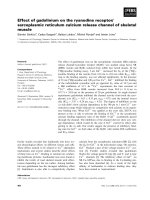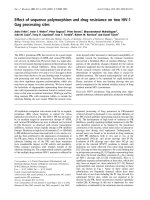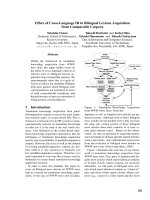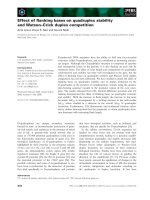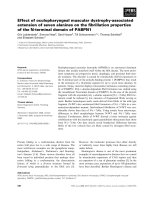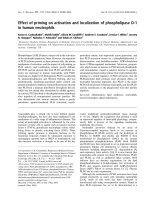Báo cáo khoa học: Effect of oxidative stress and involvement of poly(ADP-ribose) polymerase (PARP) in Dictyostelium discoideum development doc
Bạn đang xem bản rút gọn của tài liệu. Xem và tải ngay bản đầy đủ của tài liệu tại đây (332.96 KB, 8 trang )
Effect of oxidative stress and involvement of
poly(ADP-ribose) polymerase (PARP) in
Dictyostelium discoideum development
Jyotika Rajawat*, Iqbal Vohra*, Hina A. Mir, Dhaval Gohel and Rasheedunnisa Begum
Department of Biochemistry, Faculty of Science, The Maharaja Sayajirao University of Baroda, Vadodara, India
Dictyostelium discoideum, a unicellular eukaryote,
exhibits multicellularity upon nutrient starvation and
thus provides a simple but excellent model system for
the study of various signal transduction pathways [1],
the findings of which can later be confirmed with
complex eukaryotic systems. D. discoideum in the
unicellular stage is known to be highly resistant to
DNA-damaging agents and oxidative stress [2,3].
However, the response of D. discoideum development
to oxidative stress is not clearly understood. Recent
studies showed that superoxide plays a vital role in the
aggregation process of D. discoideum cells [4], as
inhibition of superoxide-dependent signaling events
affects the transition from the unicellular to the multi-
cellular phase. During development, D. discoideum cells
produce nitric oxide, which is also postulated to act as
a signaling molecule [5].
Reactive oxygen species (ROS) nevertheless also
have deleterious effects and are known to cause DNA
damage [6], which in turn results in the activation of
poly(ADP-ribose) polymerase (PARP). This catalyzes
the transfer of ADP-ribose moieties to acceptor pro-
teins by utilizing NAD
+
as the substrate, and helps in
DNA repair [7,8]. PARP also monitors the status of
DNA before entry into mitosis [9,10], and hence has
been implicated in checkpoint control. Cells are
Keywords
benzamide; development; Dictyostelium
discoideum; oxidative stress; PARP
Correspondence
R. Begum, Department of Biochemistry,
Faculty of Science, The Maharaja Sayajirao
University of Baroda, Vadodara-390002,
India
Fax: +91 265 2795563
Tel: +91 265 2795594
E-mail:
*These authors contributed equally to this
work
(Received 16 June 2007, revised 23 August
2007, accepted 3 September 2007)
doi:10.1111/j.1742-4658.2007.06083.x
Dictyostelium discoideum, a unicellular eukaryote, exhibits multicellularity
upon nutrient starvation and is a good model system for developmental
studies, and for the study of various signal transduction pathways. Reac-
tive oxygen species at low doses act as signaling molecules; however, at
high doses they are known to cause DNA damage that results in the acti-
vation of poly(ADP-ribose) polymerase (PARP). We have earlier reported
the high resistance of the unicellular stage of D. discoideum to oxidative
stress, and we now show the response of this organism to oxidative stress
and the role of PARP during development. We used hydroxylamine (HA)
to induce in situ generation of H
2
O
2
and monitored the effect of
benzamide, a PARP inhibitor, on oxidative stress-induced changes in
D. discoideum development. Interestingly, oxidative stress resulted in PARP
activation within 5 min that was inhibited by benzamide. Oxidative stress-
induced delay in developmental pattern was also partially restored by
benzamide. We studied the long-term effects of PARP inhibition under
oxidative stress, and our results demonstrated that spores formed under
HA stress exhibited significant delay in germination in comparison to
benzamide-pretreated HA-stressed cells. However, second-generation cells
showed normal development, signifying that PARP inhibition has no
deleterious effect on D. discoideum development under oxidative stress.
Abbreviations
FITC, fluorescein isothiocyanate; HA, hydroxylamine; LD, lethal dose; PAR, poly(ADP-ribose); PARP, poly(ADP-ribose) polymerase; PBA,
phosphate-buffered agar; ROS, reactive oxygen species; SB, Sorenson’s buffer.
FEBS Journal 274 (2007) 5611–5618 ª 2007 The Authors Journal compilation ª 2007 FEBS 5611
arrested at different phases of the cell cycle, depending
upon the extent of PARP activation [11] under stress
conditions. Thus, in higher eukaryotic cells, PARP
contributes to cell homeostasis under mild stress condi-
tions, and conversely, during conditions of moder-
ate ⁄ severe cellular stress, PARP overactivation leads to
cell death, which results in several disease conditions
[12]. Pharmacological inhibition of PARP during mod-
erate ⁄ severe cellular stress is beneficial [13,14]; how-
ever, the consequences of such inhibition for genomic
integrity are not yet understood. D. discoideum is
reported to have nine potential PARP genes [15],
unlike another unicellular eukaryote, Saccharomyces
cerevisiae [16]. Hence, we selected D. discoideum as a
model system to study the role of PARP in its develop-
ment under oxidative stress conditions.
We have studied the dose-dependent effect of
hydroxylamine (HA) (for in situ H
2
O
2
generation) on
D. discoideum development and also the role of PARP
in oxidative stress-induced effects on development.
Our present study is the first report on the activation
of PARP under oxidative stress in D. discoideum, and
our results suggest that D. discoideum is an excellent
model system with which to investigate the long-term
effects of PARP inhibitors for two successive
generations.
Results
Dose-dependent effect of oxidative stress on
D. discoideum cell death
Cell death was induced by treating D. discoideum cells
for 1 h with different concentrations (1.0, 2.5 and
4.0 mm) of HA, a known catalase inhibitor [17], in
order to promote in situ generation of H
2
O
2
.
HA-induced cell death was measured after 24 h by the
Trypan blue exclusion method. The percentage of cells
undergoing cell death was found to increase from 15%
to 90% as the concentration of HA was increased
from 1.0 mm to 4.0 mm, and 50% cell death was seen
at 2.5 mm HA (Fig. 1).
D. discoideum growth under oxidative stress
To monitor the effect of HA on the D. discoideum cell
cycle, a growth curve was obtained. The growth curve
showed a dose-dependent increase in the lag phase
from 36 h to 60 h, 72 h and 96 h at lethal dose
(LD)15 (1 mm), LD50 (2.5 mm) and LD90 (4 mm),
respectively. Furthermore, the log phase was shortened
to 48 h, 48 h and 36 h at LD15, LD50 and LD90,
followed by faster attainment of stationary phase
(Fig. 2), suggesting that HA caused cell cycle arrest
leading to an increased lag phase.
D. discoideum development under oxidative
stress
To study the effect of oxidative stress on differentia-
tion, developmental studies were performed. The
dose-dependent effect of HA on D. discoideum devel-
opment was studied by exposing the cells to different
concentrations of HA (1.0, 2.5 and 4.0 mm) for 1 h
and then allowing them to develop. As can be seen
from Table 1 and Fig. 3A, development was delayed
in a dose-dependent manner at the loose aggregation
stage by 2 h and 12 h at LD15 and LD50 of HA,
100
80
60
% Cell Death
40
20
0
Control
1 m
M 2.5 mM 4 mM
n=3
Fig. 1. Dose-dependent effect of HA on D. discoideum cell death
determined by the Trypan blue exclusion method. Cells were trea-
ted with different doses of HA, and cell death was assessed by
the Trypan blue method after 24 h. HA at 1 m
M caused 15% cell
death, and hence this dose was considered to be LD15; a 2.5 m
M
dose was found to be LD50, as 50% of cells were dead; 4 mM HA
was found to be LD90, as this dose caused 90% cell death.
14
12
10
8
Number of Cells in Million
6
4
2
0
Time (h)
Control
1.0 m
M HA
(LD15)
2.5 m
M HA
(LD50)
4.0 mM HA
(LD90)
Bnz + 2.5 m
M
HA (LD50)
n=3
12
24
36
48
60
72
84
96
108
120
132
146
Fig. 2. Effect of PARP inhibition during oxidative stress-induced
growth changes in D. discoideum. Under oxidative stress, the
growth curve showed a dose-dependent increase in the lag phase.
The log phase was shortened, and this was followed by faster
attainment of stationary phase. Benzamide-pretreated cells showed
a reduction in the lag phase from 72 to 60 h at LD50, followed by a
longer log phase. Results are means of three independent experi-
ments performed in duplicate.
PARP in Dictyostelium discoideum development J. Rajawat et al.
5612 FEBS Journal 274 (2007) 5611–5618 ª 2007 The Authors Journal compilation ª 2007 FEBS
respectively, as compared to control cells. At 18 h of
development, 40% loose aggregates were seen in
2.5 mm HA as compared to controls. The percentage
involvement of cells was slightly increased with time.
Nevertheless, cells treated with LD90 of HA showed
no development until after 1 week, suggesting that
development was arrested. HA-treated D. discoideum
cells exhibited dose-dependent decreases in the num-
ber and size of fruiting bodies as compared to control
cells (Fig. 3B).
Oxidative stress induces PARP activation
PARP activity in D. discoideum was assayed at various
time points (5, 10, 20 and 60 min and 4 h) after HA
stress. PARP activity was increased initially, and sig-
nificant peak PARP activity was seen at 5 min after
exposure of the cells to 2.5 mm HA (Fig. 4A,B). No
difference in fluorescence intensities was observed at
time points after 10 min.
PARP inhibition by benzamide
To address the role of PARP under oxidative stress,
PARP inhibition studies were performed. Peak PARP
activity, which was observed after 5 min of 2.5 mm
HA exposure, was significantly inhibited by 1 mm ben-
zamide (Fig. 4A,B), confirming PARP activation in
D. discoideum under oxidative stress.
PARP inhibition during oxidative stress-induced
growth changes in D. discoideum
PARP inhibition conferred protection against 2.5 mm
HA-induced delay in growth. The lag phase in
benzamide-pretreated cells was reduced from 60 h
to 50 h, and was followed by a longer log phase
(Fig. 2).
Role of PARP during D. discoideum development
The role of PARP in D. discoideum development
was investigated by its inhibition with benzamide.
Table 1. Developmental stages of D. discoideum at different time
intervals. Cells (2.5 · 10
6
) were treated with 2.5 mM and 4 mM HA
for 1 h, plated on non-nutrient agar, and observed at different time
points. Also shown is the effect of PARP inhibition by benzamide
during oxidative stress on D. discoideum development. LA, loose
aggregate; TA, tight aggregate; SF, slug formation; FBF, fruiting
body formation; CD, cell death; FB, fuiting body; –, no development
until after 1 week.
LA
(h)
TA
(h)
SF
(h)
FBF
(h)
%
CD
%
FB
HA (m
M)
0.0 6 12 18 24 1 100
1.0 8 14 20 26 15 100
2.5 18 24 30 36 50 30
4.0 – – – – 90 –
HA (m
M)+1mM benzamide
0.0 6 12 18 24 1 100
1.0 6 12 18 24 5 100
2.5 12 17 23 29 20 70
4.0 18 24 30 36 40 20
A
Control
B
1mM HA
2.5m
M HA
4m
M HA
Fig. 3. Development of D. discoideum cells at 12 and 24 h under oxidative stress. (A) Developmental phenotypes of control and 1 mM
HA-treated D. discoideum cells at 12 h. Cells after HA treatment were starved on nutrient-free agar medium and photographed at 4· magni-
fication. (B) Developmental stages of control cells, and 2.5 m
M and 4 mM HA-treated cells, at 24 h. Scale bar, 10 lm. Results are means of
three independent experiments performed in duplicate.
J. Rajawat et al. PARP in Dictyostelium discoideum development
FEBS Journal 274 (2007) 5611–5618 ª 2007 The Authors Journal compilation ª 2007 FEBS 5613
Benzamide (1.0, 2.0 and 3.0 mm) did not show any
effect on development. However, benzamide at 4 mm
caused a 3–4 h delay in the tight aggregate-to-slug
transition (Table 2). Interestingly, D. discoideum cells
treated with 3.0 and 4.0 mm benzamide showed abnor-
mal fruiting bodies with larger fruits.
PARP involvement during oxidative
stress-induced developmental changes
in D. discoideum
To determine the role of PARP in oxidative stress-
induced developmental changes, D. discoideum cells
were exposed to benzamide (1 mm for 24 h) prior to
HA (LD15, LD50 and LD90) treatment, and allowed
to develop; the results are shown in Table 1. Benza-
mide-pretreated cells, upon exposure to a high dose of
HA (2.5 mm), exhibited development, and the delay at
the loose aggregation stage was reduced from 18 h to
12 h (Table 1). The percentage of loose aggregates
formed was also increased, whereas in the case of
LD90, delayed development could be observed in the
presence of benzamide, as compared to developmental
arrest of 4 mm HA-treated cells. The fruiting bodies
formed were very small, with poor stalks and small
fruits, and the fruits were few in number (Fig. 5).
PARP inhibition restored spore germination that
was delayed due to oxidative stress
To investigate the germination efficiency of spores and
the fate of the germinated amoebae, spore revival was
attempted. Control and benzamide-treated spores ger-
minated within 108–120 h, whereas the spores formed
under 2.5 mm HA stress showed a significant delay,
i.e. 56 h (P<0.001) in germination. There was a
partial rescue of the developmental delay, i.e. 32 h
(P<0.012) in the presence of benzamide. Spores
formed from benzamide-pretreated and 4 mm HA-trea-
ted cells germinated after 60 h as compared to controls
(Fig. 6). To avoid ambiguity in the number of fruiting
bodies added to each flask, fruiting bodies were picked
up from at least four different areas and it was ensured
that a single fruiting body was inoculated per milliliter
of medium. Our results were also confirmed by micro-
scopically counting the number of cells germinated
from each spore, and this was found to be the same
for each dose.
For spore revival when log phase had been reached
(2.5 · 10
6
cells ⁄ mL), the cells were plated on phos-
phate-buffered agar (PBA) plates for development, and
cells treated with 2.5 mm and 4 mm HA exhibited
normal development (data not shown).
Discussion
Among the eukaryotic organisms, the cellular slime
mold D. discoideum is an excellent model system for
studying cell death and developmental aspects [18].
The ability of living cells to cope with various stresses
is very crucial for maintaining their correct develop-
ment. ROS at lower concentrations have physiological
A
Control 2.5 m
M HA-5min
2.5 m
M HA-10min
70
60
50
40
30
Mean Density
20
10
0
Control
2.5m
M-5'
Bnz-2.5m
M HA
n=3
Bnz+2.5 m
M HA-5min
B
Fig. 4. Fluorescence images for PARP assay under 2.5 mM HA
stress at varying time intervals. (A) Cells after treatment with HA
were fixed and incubated with antibody to PAR, and were then
treated with FITC-conjugated secondary antibody to assess PARP
activity. PAR immunoreactivity was barely detectable in controls,
whereas peak activity was seen at 5 min after 2.5 m
M HA stress,
and was reduced to basal level by 10 min. Benzamide significantly
inhibited peak PARP activation. (B) Representation of the results
for PARP activation in the form of a histogram; a significant
increase in PARP activity was seen at 5 min. P < 0.001.
Table 2. Effect of the PARP inhibitor benzamide on D. discoideum
development. LA, loose aggregate; TA, tight aggregate; SF, slug
formation; FBF, fruiting body formation; CD, cell death; FB, fruiting
body.
Benzamide
(m
M)
LA
(h)
TA
(h)
SF
(h)
FBF
(h)
%
CD
%
FB
0.0 6 12 18 24 1 100
1.0 6 12 18 24 2 100
2.0 6 12 18 24 2 100
3.0 6 12 18 24 4 95
4.0 6 12 22 28 10 95
PARP in Dictyostelium discoideum development J. Rajawat et al.
5614 FEBS Journal 274 (2007) 5611–5618 ª 2007 The Authors Journal compilation ª 2007 FEBS
functions and serve as second messengers in different
signal transduction pathways [19]; however, ROS at
higher concentrations cause DNA damage [20] among
other cytotoxic effects. PARP is known to play an
important role under oxidative stress [21]; however,
there is no report on the role of PARP in D. discoideum
development. We have investigated the role of PARP in
D. discoideum development by inhibiting its activity
with the known PARP inhibitor benzamide, and stud-
ied its effects on development and oxidative stress-
induced development. Our results suggest that 2.5 mm
HA delayed development due to cell cycle arrest,
whereas 4 mm HA caused 90% cell death, meaning
that cell density was not sufficient for aggregation,
leading to complete developmental arrest. Our results
show that D. discoideum exhibits basal PARP activity
(Fig. 4A), and its inhibition by benzamide (1–3 mm)
did not affect development. However, benzamide
(4 mm)-treated D. discoideum cells were unable to
differentiate properly (Table 2) and exhibited delayed
development, especially at the differentiation stage of
prestalk and prespore formation. These results suggest
that lower doses of benzamide have no deleterious
effects on D. discoideum development.
HA-induced oxidative stress activates PARP within
5 min (Fig. 4A,B), and its role during oxidative stress
is further confirmed by the use of low concentrations
of benzamide. Preincubation of cells with benzamide
prevented the peak activity observed during oxidative
stress (Fig. 4A,B). Under oxidative stress, partial inhi-
bition of PARP activity led to altered growth, suggest-
ing that oxidative stress could be leading to cell cycle
arrest [22] and that PARP inhibition possibly over-
comes this arrest. PARP inhibition also rescued
the oxidative stress-induced delay in development
(Table 1), although the fruiting body was smaller than
in controls (Fig. 5). Thus, our results suggest not only
the presence of PARP in D. discoideum, but also its
overactivation under moderate to severe oxidative
stress. Our present study is the first report on the role
of PARP in D. discoideum development.
PARP inhibitors are powerful cell-protective agents
that block cell death in response to oxidative stress
and hence are used as therapeutic molecules to control
oxidative stress-related diseases [12]. However, the con-
sequences of the blockade of cell death by PARP
inhibitors for long-term cell survival are not entirely
clear. In this context, we have studied the effect of
PARP inhibition under oxidative stress on two genera-
tions by reviving the spores and monitoring growth
and doubling time. It was found that in normal cells,
PARP inhibition (1 mm benzamide) has no effect on
spore germination. However, when cells were exposed
to oxidative stress (2.5 mm HA) and allowed to
develop, the spores remained dormant for longer time
12
Control
Bnz
2.5 m
M HA
10
8
No. of Cells in Million
6
4
2
0
Time (h)
n = 3
108
132
156
180
204
228
252
276
300
324
348
Bnz+2.5 mM HA
Bnz+4 m
M HA
Fig. 6. Effect of PARP inhibition on the fate of spores that were
developed under oxidative stress. Spores of control cells germi-
nated within 108 h, whereas spores formed under oxidative
(2.5 m
M HA) stress exhibited a 56 h delay in germination, which
was partially rescued by benzamide pretreatment. Spores formed
from cells that were pre-exposed to benzamide and HA-stressed
(2.5 and 4 m
M HA) germinated earlier than cells treated only with
2.5 m
M HA; 4 mM HA-treated cells showed no development and
hence no spores. Data are means of three independent experi-
ments performed in duplicate.
20 microns
Fig. 5. Effect of PARP inhibition during oxidative stress-induced developmental changes in D. discoideum. Cells were preincubated with 1 mM
benzamide for 24 h, treated with HA, washed, and plated at a density of 2 · 10
5
cellsÆcm
)2
. Benzamide pretreatment restored the develop-
ment that was delayed by 2.5 m
M HA, and rescued the developmental arrest of 4 mM HA-treated cells. The arrow indicates the fruiting body.
Fruiting body formation at different time intervals in the development of HA-treated cells pre-exposed to benzamide is shown. The fruiting body
was small in comparison to that of controls. Scale bar, 20 lm. Data are means of three independent experiments performed in duplicate.
J. Rajawat et al. PARP in Dictyostelium discoideum development
FEBS Journal 274 (2007) 5611–5618 ª 2007 The Authors Journal compilation ª 2007 FEBS 5615
as compared to control spores, as the spores took
more time (56 h) to germinate as compared to control
spores. Conversely, when cells were exposed to oxida-
tive stress (2.5 mm and 4 mm HA) with PARP inhibi-
tion and allowed to develop, the spores showed faster
germination (32 h and 60 h) as compared to cells
exposed to oxidative stress alone (2.5 mm HA), as seen
in Fig. 6. Interestingly, the amoebae thus formed due
to spore germination (2.5 and 4 mm HA with and
without PARP inhibition) exhibited normal develop-
ment (data not shown), suggesting that second-genera-
tion cells had overcome the effect of oxidative stress.
Thus, our results demonstrate that partial PARP inhi-
bition under mild or severe oxidative stress did not
affect repair of the damage incurred due to oxidative
stress, as the amoebae formed upon spore germination
exhibited normal growth and development for two suc-
cessive generations. Our data support the idea that
PARP inhibition is beneficial under oxidative stress
and that PARP inhibitors are potential therapeutic
molecules for the control of oxidative stress-related
diseases. This study also opens the possibility for iden-
tifying the genes involved in D. discoideum spore dor-
mancy under stress conditions.
Experimental procedures
Materials
Hydroxylamine, benzamide and anti-mouse IgG (whole mol-
ecule) fluorescein isothiocyanate (FITC) conjugate developed
in rabbit were obtained from Sigma Aldrich (St Louis, MO),
and mouse mAb (10H) to poly(ADP-ribose) (PAR) (Ab-1)
was obtained from Calbiochem (San Diego, CA, USA).
Cell culturing
D. discoideum cells (Ax-2 strain) were grown in suspension
in HL5 medium with shaking at 150 r.p.m. and 22 °C.
Developmental studies were carried out on non-nutrient
agar plates. All the experiments were carried out with
D. discoideum cells at mid-log phase with a cell density of
2.5 · 10
6
cellsÆmL
)1
. Amoebae were washed with 1 · Soren-
son’s buffer (SB) (17 mm potassium phosphate, pH 6.4) by
centrifugation at 300 g for 5 min, and spread on phosphate-
buffered agar (PBA) plates at a density of 2.5 · 10
5
cellsÆcm
)2
. The plates were allowed to develop at 22 °C.
Dose-dependent effect of HA on D. discoideum
cell death
Cells (2.5 · 10
6
) were harvested by centrifugation at 300 g
for 5 min at 4 °C, resuspended in HL5 medium, exposed to
different doses (1.0, 2.5 and 4.0 mm) of HA, and shaken at
150 r.p.m. at 22 °C for growth [23]. Cell death was checked
by a Trypan blue exclusion method after 24 h.
Effect of HA on D. discoideum growth
Cells (0.5 · 10
6
) were harvested by centrifugation at 300 g
for 5 min at 4 °C, resuspended in 4 mL of HL5 medium so
that the cells entered lag phase, and then exposed to differ-
ent concentrations (1.0, 2.5 and 4.0 mm) of HA for 1 h.
The cells were washed with 1 · SB two or three times, and
finally suspended in HL5 medium (pH 6.5) and shaken at
150 r.p.m. and 22 °C for growth. The cells were counted
using a hemocytometer every 12 h up to 132 h (6 days)
[23].
Effect of HA on D. discoideum development
Cells (2.5 · 10
6
) were harvested and processed as described
above for HA treatment (1.0, 2.5 and 4.0 mm), and the
cells were then resuspended in 100 lLof1· SB and
spread on non-nutrient agar plate (PBA plates). The plates
were kept at 22 °C, and different stages of development
were observed. Grids 1 mm square were made on a
35 mm plate, and then fruiting bodies in five such squares
of different regions were counted under a microscope.
Approximately 40 fruiting bodies were counted in the
experiment.
PARP activation under HA stress
Cells treated with different doses of HA were centrifuged
and washed once with NaCl ⁄ Pi, fixed in 70% chilled metha-
nol for 10 min at ) 20 °C, washed with blocking solution
(1.5% BSA with 0.05% Tween-20 in NaCl ⁄ P
i
), and then
incubated for 1 h with antibody to PAR raised in mouse at
a concentration of 0.5 lgÆmL
)1
[24]. Cells were washed two
or three times with blocking solution, and incubated for 1 h
with FITC-conjugated anti-mouse IgG as secondary anti-
body, used at a dilution of 1 : 200. Cells were washed two
or three times with NaCl ⁄ P
i
, and fluorescence was observed
at 60· magnification using a Nikon (Tokyo, Japan) fluores-
cence microscope with a charge-coupled device camera;
results are shown for 2.5 mm HA only. Data were analyzed
by image proplus software to calculate the mean density of
fluorescence from different fields, and 50 cells were exam-
ined for each dose.
PARP inhibition by benzamide
A culture in log phase with a cell count of 1.0 · 10
6
cells
was incubated with 1 m m benzamide, a PARP inhibitor
[25], for 24 h. Cells were then treated with 2.5 mm HA and
observed for PARP activation as for the PARP assay.
PARP in Dictyostelium discoideum development J. Rajawat et al.
5616 FEBS Journal 274 (2007) 5611–5618 ª 2007 The Authors Journal compilation ª 2007 FEBS
Effect of benzamide on HA-induced changes to
D. discoideum growth
Cells (0.5 · 10
6
) were treated with the 1 mm benzamide for
24 h, and then the cells were exposed to HA (2.5 mm) for
1 h. Cells were washed and resuspended in 4 mL of sterile
HL5, and growth was monitored for 6 days.
Dose-dependent effect of benzamide on
D. discoideum development
Cells (1.0 · 10
6
) were harvested, resuspended in HL5 med-
ium, and exposed to different concentrations (1.0, 2.0, 3.0
and 4.0 mm) of benzamide for 24 h at 22 °C. After 24 h of
incubation, the cells were washed three times with 1 · SB
and processed for development.
Effect of benzamide on oxidative stress-induced
changes to D. discoideum development
Cells (1.0 · 10
6
) were harvested, resuspended in HL5 med-
ium, and exposed to 1 mm benzamide for 24 h at 22 °C.
After 24 h of incubation, cells were treated with different
concentrations of HA (2.5 and 4.0 mm) for 1 h. The cells
were then centrifuged at 300 g, washed two or three times
with 1 · SB, plated on PBA plates, and monitored for devel-
opment.
Effect of benzamide on the fate of spores formed
under HA stress
Spores formed after treatment with 2.5 and 4 mm HA in
the presence and absence of benzamide were picked from
different areas with the help of a sterilized nichrome loop,
and added to 5 mL of HL5 medium. Flasks were continu-
ously shaken at 150 r.p.m. and 22 °C. After germination,
the cells were counted every 12 h using a hemocytometer.
Acknowledgements
Infrastructure facilities provided by Maharaja Sayaj-
irao University are gratefully acknowledged. R. Begum
thanks the Department of Biotechnology, New Delhi
for research support (BT ⁄ PR 4651 ⁄ BRB ⁄ 10 ⁄ 356 ⁄ 2004),
and J. Rajawat thanks the Council of Scientific and
Industrial Research (New Delhi) for awarding JRF.
Our sincere thanks go to Dr Rekha Rai from the
Advanced Center for Treatment, Research and Educa-
tion in Cancer (ACTREC), Mumbai for her help.
References
1 Mir HA, Rajawat J, Pradhan S & Begum R (2007) Sig-
naling molecules involved in the transition of growth to
development of Dictyostelium discoideum. Indian J Exp
Biol 45, 223–226.
2 Welker DL & Deering RA (1978) Genetics of radiation
sensitivity in the slime mould of Dictyostelium discoide-
um. J Gen Microbiol 109, 11–23.
3 Katoch B & Begum R (2003) Biochemical basis of the
high resistance to oxidative stress in Dictyostelium dis-
coideum. J Biosci 28, 581–588.
4 Bloomfield G & Pears C (2003) Superoxide signalling
required for multicellular development of Dictyostelium.
J Cell Sci 116, 3387–3397.
5 Tao YP, Misko TP, Howlett AC & Klein C (1997)
Nitric oxide, an endogenous regulator of Dictyostelium
discoideum differentiation. Development 124, 3587–3595.
6 Du L, Zhang X, Han YY, Burke NA, Kochanek PM,
Watkins SC, Graham SH, Carcillo JA, Szabo C &
Clark RSB (2003) Intra-mitochondrial poly(ADP-ri-
bosylation) contributes to NAD
+
depletion and cell
death induced by oxidative stress. J Biol Chem 278,
18426–18433.
7 Burkle A (2001) Physiology and pathophysiology of
poly(ADP-ribosyl)ation. Bioessays 23, 795–806.
8 D’Amours D, Desnoyers S, D’Silva I & Poirier GG
(1999) Poly(ADP-ribosyl)ation reactions in the regula-
tion of nuclear functions. Biochem J 342, 249–268.
9 Oliver FJ, de la Rubia G, Rolli V, Ruiz-Ruiz MC,
de Murcia G & Murcia JM (1998) Importance of poly
(ADP-ribose) polymerase and its cleavage in apoptosis.
J Biol Chem 273, 33533–33539.
10 Hoger T, de Murcia MJ & de Murcia G (1999) PARP-2,
a novel mammalian DNA damage-dependent poly(ADP-
ribose) polymerase. J Biol Chem 274, 17860–17868.
11 Horton JK, Stefanick DF, Naron JM, Kedar PS &
Wilson SH (2005) Poly(ADP-ribose) polymerase activity
prevents signaling pathways for cell cycle arrest after
DNA methylating agent exposure. J Biol Chem 280,
15773–15785.
12 Virag L & Szabo C (2002) The therapeutic potential of
poly(ADP-ribose) polymerase inhibitors. Pharmacol Rev
54, 375–429.
13 Palomba L, Sestili P, Cattabeni F, Azzi A & Cantoni O
(1996) Prevention of necrosis and activation of apopto-
sis in oxidatively injured human myeloid leukemia U937
cells. FEBS Lett 390, 91–94.
14 Virag L, Scott GS, Cuzzocrea S, Marmer D, Salzman
AL & Szabo C (1998) Peroxynitrite-induced thymocyte
apoptosis: the role of caspases and poly(ADP-ribose)
synthetase (PARS) activation. Immunology 94, 345–355.
15 Otto H, Reche PA, Bazan F, Dittmar K, Haag F &
Koch-Nolte F (2005) In silico characterization of the
family of PARP-like poly(ADP-ribosyl) transferases
(pARTs). BMC Genomics 6, 139–161.
16 Perkins E, Sun D, Nguyen A, Tulac S, Francesco M,
Tavana H, Nguyen H, Tugendreich S, Barthmaier P,
J. Rajawat et al. PARP in Dictyostelium discoideum development
FEBS Journal 274 (2007) 5611–5618 ª 2007 The Authors Journal compilation ª 2007 FEBS 5617
Couto J et al. (2001) Novel inhibitors of poly(ADP-
ribose) polymerase ⁄ PARP1 and PARP2 identified using
a cell-based screen in yeast. Cancer Res 61, 4175–4183.
17 Kono Y & Fridovich I (1983) Isolation and character-
ization of the pseudocatalase of Lactobacillus plantarum.
J Biol Chem 258, 6015–6019.
18 Escalante R & Vicente JJ (2000) Dictyostelium discoide-
um: a model system for differentiation and patterning.
Int J Dev Biol 44, 819–835.
19 Firtel RA (1991) Signal transduction pathways control-
ling multicellular development in Dictyostelium. Trends
Genet 7, 381–388.
20 Cooke MS, Evans MD, Dizdaroglu M & Lunec J
(2003) Oxidative DNA damage: mechanisms, mutation,
and disease. FASEB J 17, 1195–1214.
21 Bakondi E, Bai P, Szabo E, Hunyadi J, Gergely P,
Szabo C & Virag L (2002) Detection of poly(ADP-
ribose) polymerase activation in oxidatively stressed
cells and tissues using biotinylated NAD substrate.
J Histo Cyto 50, 91–98.
22 Shapira M, Segal E & Botstein D (2004) Disruption of
yeast forkhead-associated cell cycle transcription by oxi-
dative stress. Mol Biol Cell 15, 5659–5669.
23 Vohra I (2005) Effect of UV-C irradiation and oxidative
stress on Dictyostelium discoideum growth, development
and cell death. MPhil Dissertation, MS University of
Baroda, Vadodara.
24 Cole KK & Perez Polo JR (2002) Poly (ADP) ribose
polymerase inhibition prevents both apoptotic-like
delayed neuronal death and necrosis after H
2
O
2
injury.
J Neurochem 82, 19–29.
25 Szabo C & Dawson VL (1998) Role of poly(ADP-
ribose) synthetase in inflammation and ischaemia–reper-
fusion. Trends Pharmacol Sci 19, 287–298.
PARP in Dictyostelium discoideum development J. Rajawat et al.
5618 FEBS Journal 274 (2007) 5611–5618 ª 2007 The Authors Journal compilation ª 2007 FEBS



